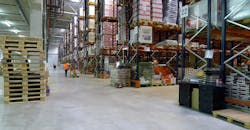Get Serious about Warehouse Amenities and Sustainability
This year could represent the first step in the transformation of commercial real estate based on rejecting what used to be considered normal commercial real estate design and operational practices, say researchers for Jones Lang LaSalle Inc. (JLL).
They believe those changes will result in better working conditions for supply chain essential workers, increased need for distribution space in high population areas to meet the demands of burgeoning e-commerce, and paying closer attention to meeting real sustainability goals.
“After a year of research, surveys, interviews and analysis, we can state with confidence that we will never return to what most people considered ‘normal’ at the beginning of 2020. The world has evolved and accelerated in ways that will alter the course of our future and there is no going back,” states Christian Beaudoin, senior director of research for JLL.
The JLL researchers say we will never go back to the same office, industrial and shopping environments that were taken for granted just a year ago. Previously accepted assumptions and attitudes have changed. They firmly believe we will never return to the same world we left behind, and offer their views on the changes business leaders need to embrace.
“We also recognize that many of the changes we are recommending are the result of an evolving economy, one in which rapid urbanization and technological advancements of the past decade have made it possible to envision what could be next,” Beaudoin stresses. “So, let’s not try to get back to normal. Let’s work together to achieve conditions that are better than normal in 2021, in every aspect of how we live, work and play.”
A major change in 2021 will be warehouse spaces and distribution centers (DCs) designed with essential workers in mind, according to Mehtab Randhawa, JLL director, industrial research. “Of course, location matters in logistics, but amenities and technology in DCs will increase in importance as well,” she says.
In 2021, the leading designers and developers of logistics properties are expected to pay greater attention to ergonomics and worker wellness.
“In an already competitive labor market, these amenities within warehouse spaces can help in attracting more workers while also providing a safer, healthier and more enjoyable environment for employees,” Randhawa observes.
In the past, while we saw something of an “amenities race” in the office sector, she notes that employees in the warehouse sector still have only an 8% chance of working in a building with air conditioning. Randhawa believes that a human-centric approach to warehouse operations combined with technology will enhance productivity by allowing workers to focus more on order fulfillment and problem-solving while robots increasingly perform repetitive and sometimes dangerous tasks.
She emphasizes that basic building amenities should include enhanced air handling and filtration systems, natural lighting and purified hydration filtration systems to advance employee health. The next level of amenities will include fitness centers, community spaces, private relaxation rooms and outdoor access.
Randhawa also believes that in the future competitive industrial buildings will offer shuttle services to and from public transit for employees in urban areas. Some developers already are planning more purposeful integration with their surrounding communities, with projects ranging from building walking paths to offering local career training.
Location and Sustainability
JLL expects e-commerce sales to hit $1.5 trillion by 2025, which will increase demand for industrial real estate by another 1 billion square feet. Preliminary results indicate that e-commerce grew by 20% in 2020 alone, and as much as 50% of industrial leasing activity this year has already been attributed to related e-commerce operations.
“With no shortage of investment capital interested in the industrial sector, the question is not so much what to build but where to build first,” the researchers say. “With a focus on customer convenience and access, a sector which has already outperformed expectations can do even better in 2021.”
The markets with higher population counts and density are where JLL sees immediate existing need for last-mile facilities—the Northeast and Mid-Atlantic, Chicago, Los Angeles and San Francisco. These areas are said to have some of the lowest vacancy rates in the country and need space immediately to meet local delivery needs.
Other emerging markets may have vacancies at present but are experiencing rapid population growth and in the near future are expected to need additional last-mile facilities. These markets include Seattle, Dallas, Houston, Atlanta and Miami.
“Beyond the immediate demand that was generated from COVID 19, it is anticipated that online order demand will be sustained as more shoppers appreciate the convenience and shopping access it offers,” the JLL researchers predict. “The greatest opportunity for investors to capitalize on this trend will be in established markets, where populations are large and dense and where higher income households drive purchasing power.”
Another factor that has gained a higher profile is sustainability. In just nine years, industrial real estate developers will need to be serious about this subject. JLL points out that many companies already are demanding that industrial properties they use be carbon neutral no later than 2030. This includes Apple, Microsoft, Novartis, Timberland—and even JLL itself.
In 2021, savvy industrial owners and managers will be taking proactive steps to reduce the carbon footprint of their properties, the researchers explain. Added pressure coming from investors, consumers and regulators will encourage companies to more closely focus on evaluating the environmental impacts of their businesses.
Reducing a facility’s carbon footprint is not easy or cheap, the researchers admit. They foresee changes such as the greater use of high-efficiency roofing and insulation, LED lighting, rooftop solar panels, wind turbines and other renewable power sources.
One way is through the optimization of carbon-neutral supply chains. This can include emphasis on alternative fuel vehicles and moving operations closer together. Another way is by embracing environmentally-friendly packaging design and materials. Reusing water and recycling materials also contribute to the goal.
JLL concludes, “In 2021 the theme of sustainability will not only change the design and specification of industrial properties, but it will also be a force of change for all industrial operations. If we are to help industrial tenants achieve dramatically better environmental results by 2030, the time to start investing is now.”
About the Author

David Sparkman
founding editor
David Sparkman is founding editor of ACWI Advance (www.acwi.org), the newsletter of the American Chain of Warehouses Inc. He also heads David Sparkman Consulting, a Washington D.C. area public relations and communications firm. Prior to these he was director of industry relations for the International Warehouse Logistics Association. Sparkman has also been a freelance writer, specializing in logistics and freight transportation. He has served as vice president of communications for the American Moving and Storage Association, director of communications for the National Private Truck Council, and for two decades with American Trucking Associations on its weekly newspaper, Transport Topics.
